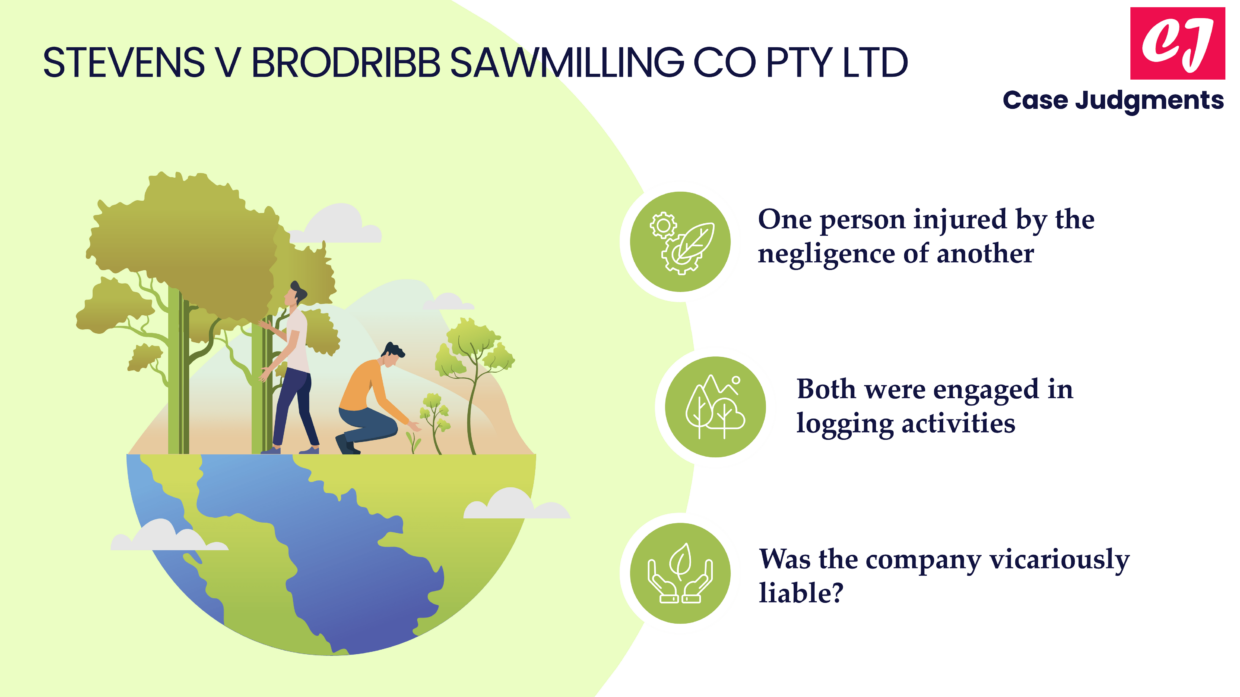
Stevens v Brodribb Sawmilling Co Pty Ltd (1986)
Stevens v Brodribb Sawmilling Co Pty Ltd (1986) is a case of workplace negligence. The case revolves around the distinction between an employee and an independent contractor. Given below are the case details:
| Case name & citation: | Stevens v Brodribb Sawmilling Co Pty Ltd (1986) 160 CLR 16 |
| The concerned Court: | High Court of Australia |
| The bench of judges: | Mason, Wilson, Brennan, Deane and Dawson JJ. |
| Decided on: | 13 February 1986 |
| Area of law: | Employment status under labour law |
Facts of the case (Stevens v Brodribb)
Brodribb Sawmilling Co Pty Ltd had a large sawmill in eastern Victoria and conducted extensive logging activities in the nearby area. The company hired people to do the requisite tasks such as felling, snigging (loading), and truck driving. Grey was hired to use a tractor that he supplied himself to push or drag felled logs to a loading ramp and then load the logs onto a truck. On the other hand, Stevens was engaged to drive the timber load to the sawmill. He was to use his personal truck for this purpose.
A “bush boss” who was an employee of Brodribb oversaw the logging activities. On the day of the incident, Gray was having trouble loading a short log onto Stevens’ truck. In an attempt to assist, Stevens used a chain to secure the log to the tractor blades. But before he walked away from there, Gray moved the tractor dislodging the log which rolled down the ramp and hurt Stevens accidentally. He sustained severe injuries and filed a claim for damages against both Gray (for his negligence) and Brodribb Sawmilling Co Pty Ltd.
Issue
The main issue, in this case, was to determine the employment status of Gray and Stevens. Whether they should be classified as employees or independent contractors?
Judgment of the Court in Stevens v Brodribb
Brodribb Sawmilling Co Pty Ltd was concerned about the legal implications of classifying the two men as either employees or independent contractors. If Gray and Stevens were deemed independent contractors, the sawmilling company could avoid vicarious liability for Gray’s negligent actions nor would it be personally liable to Stevens for breach of employer’s duty to provide adequate equipment and a safe system of work.
The High Court of Australia decided that Gray and Stevens were independent contractors. But it also established that even in cases where an individual is classified as an independent contractor, the principal may still owe a duty of care to him pursuant to the general principles of negligence. This means that the sawmilling company still had a responsibility to take reasonable precautions to ensure the safety of Stevens. Though in this specific case, on the issue of liability to the injured (Stevens), the High Court found that Brodribb had not breached its duty of care.
Employee vs Independent Contractor
In deciding the employment status of Gray and Stevens, the judges considered that the element of control alone is not the sole criterion to determine the relationship of employment. Several other factors were listed for example:
- mode of remuneration of the workers
- provision and maintenance of equipment (who provides the equipment)
- hours of work and provision for holidays or leave
- obligation to work at the employer’s direction
- the deduction of income tax
- payment of significant business expenses from remuneration
- the creation of goodwill or saleable assets
- delegation of work or sub-contracting
- work involving a specialized profession or trade
Quotes from the case
Mason J said as under:
“…the existence of control, whilst significant, is not the sole criterion by which to gauge whether a relationship is one of employment. The approach of this Court has been to regard it as merely one of a number of indicia which must be considered in the determination of that question … Other relevant matters include, but are not limited to, the mode of remuneration, the provision and maintenance of equipment, the obligation to work, the hours of work and provision for holidays, the deduction of income tax and the delegation of work by the putative employee.”
List of references:
- http://classic.austlii.edu.au/au/journals/QUTLawJl/1997/19.pdf
- https://lr.law.qut.edu.au/article/download/301/293/301-1-588-1-10-20120910.pdf
- https://www.studocu.com/en-au/document/edith-cowan-university/employment-law/law2105-employment-law-case-notes/1428163
You might also like:
More from labour law:

